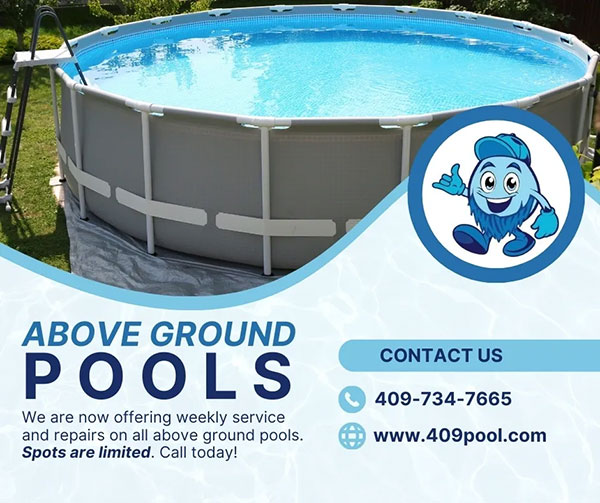Owning an above-ground pool is a fantastic way to enjoy summer fun without the high costs of an in-ground pool. However, proper maintenance is key to keeping your pool water crystal clear and safe for swimming. In this guide, we’ll cover essential steps to maintain your above-ground pool, ensuring it stays clean, balanced, and long-lasting.

1. Regular Cleaning and Skimming
One of the most important aspects of pool maintenance is keeping the water free from debris. Leaves, insects, and dirt can quickly accumulate, leading to algae growth and clogged filters.
- Use a pool skimmer daily to remove debris floating on the water.
- Vacuum the pool weekly using a manual or automatic pool vacuum to eliminate dirt from the bottom.
- Brush the pool walls and floor to prevent algae buildup, using a nylon-bristle pool brush to protect the liner.
2. Caring for the Pool Liner
Your above-ground pool liner is crucial for maintaining the structure of your pool and ensuring a smooth, leak-free experience. Proper care can extend its lifespan significantly.
- Keep sharp objects away: Avoid using sharp or rough tools near the liner, as punctures can lead to costly repairs.
- Clean gently: Use a soft sponge or cloth with a mild, non-abrasive cleaner to wipe down the liner. Avoid harsh chemicals that can degrade the material.
- Monitor for leaks: Regularly inspect the liner for small tears or leaks. If you notice bubbles or wrinkles, it may indicate water seepage underneath.
- Prevent sun damage: UV exposure can weaken the liner over time. Use a pool cover when the pool is not in use to protect against fading and wear.
- Balance water chemistry: Poor chemical balance can degrade the liner. Keep pH levels between 7.2 and 7.6, and avoid adding undissolved chlorine directly to the water, as it can cause bleaching and deterioration.
3. Water Chemistry and pH Balance
Maintaining proper chemical levels is crucial for a safe swimming environment and to prevent equipment damage.
- Test water at least twice a week using pool test strips or a liquid test kit.
- The ideal pH level should be between 7.2 and 7.6 to prevent skin irritation and ensure chlorine effectiveness.
- Maintain chlorine levels between 1-3 ppm (parts per million) to sanitize the pool and kill bacteria.
- Alkalinity should range between 80-120 ppm, while calcium hardness should be between 200-400 ppm to prevent corrosion and scaling.
4. Filtration System Maintenance
Your pool filter plays a critical role in keeping the water clean by removing dirt, algae, and small debris.
- Run your filter for at least 8-12 hours per day, especially during peak swimming season.
- Clean or replace the filter cartridge every 2-4 weeks.
- For sand or DE filters, backwash regularly to prevent clogging and maintain efficiency.
- Check and clean the skimmer and pump baskets weekly.
5. Shocking the Pool
Shocking the pool is necessary to remove contaminants and restore chlorine levels.
- Use pool shock (calcium hypochlorite or non-chlorine shock) weekly or after heavy use.
- Apply shock in the evening to allow the chemicals to work overnight without sun interference.
- Always follow manufacturer instructions and keep swimmers out of the pool for at least 12-24 hours after shocking.
6. Winterizing Your Above-Ground Pool
If you live in a region with cold winters, properly closing your pool prevents damage.
- Balance the water chemistry before closing.
- Lower the water level below the skimmer to prevent freezing damage.
- Remove, clean, and store all accessories, including ladders and hoses.
- Cover the pool with a winter pool cover to keep out debris and prevent algae growth.
Final Thoughts
Proper above-ground pool care ensures a long lifespan, reduced maintenance costs, and safe swimming conditions. By following these steps—regular cleaning, maintaining water chemistry, protecting the liner, keeping the filter system in check, shocking when needed, and winterizing—you can enjoy a clear and refreshing pool all season long. Happy swimming!




